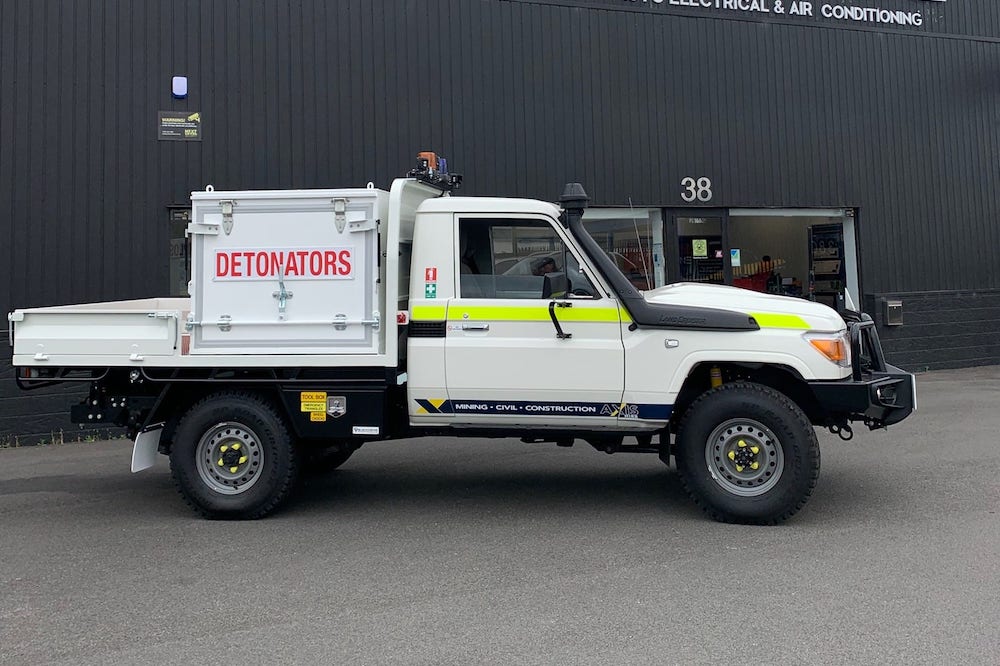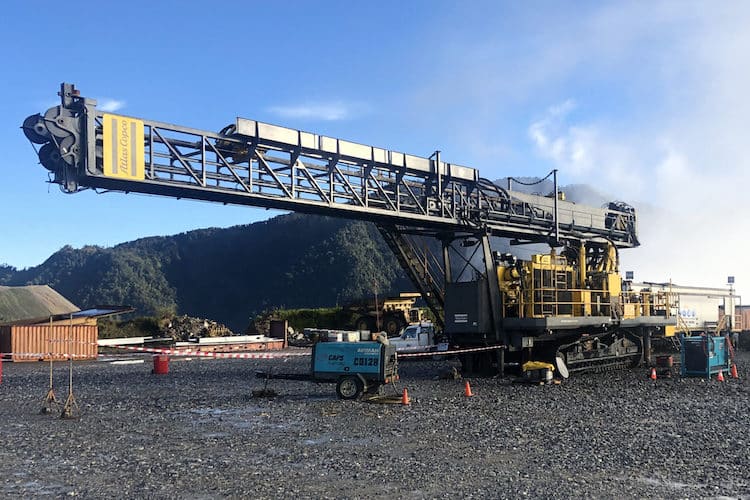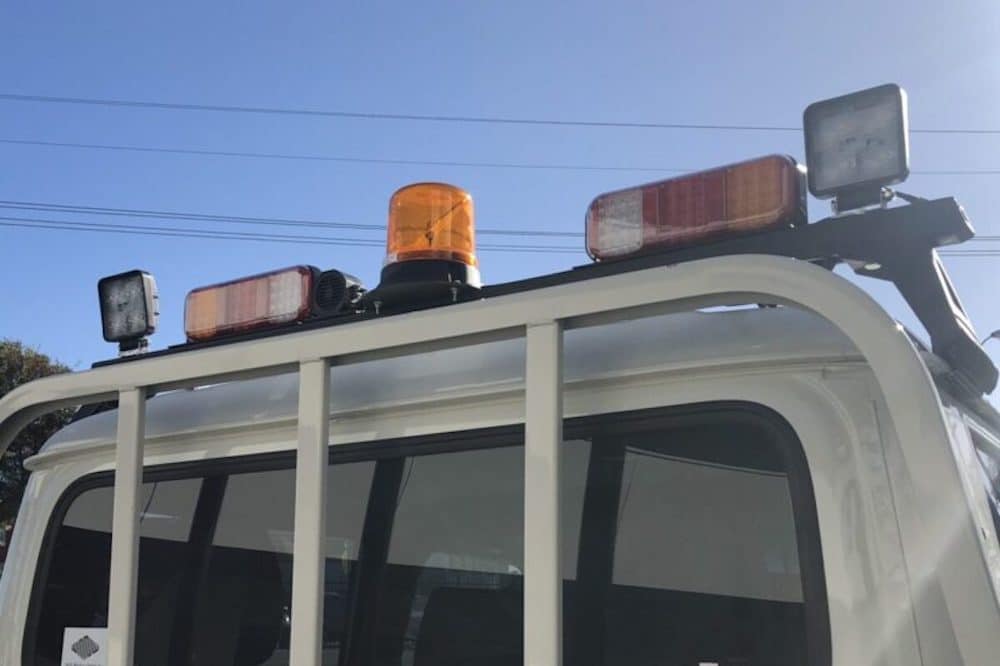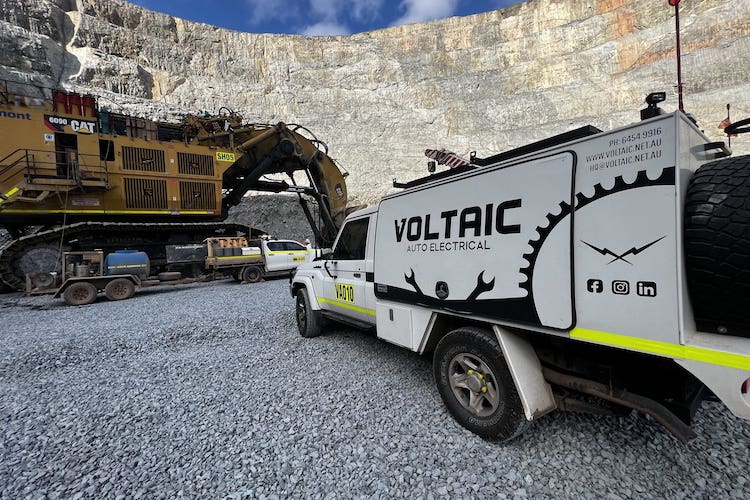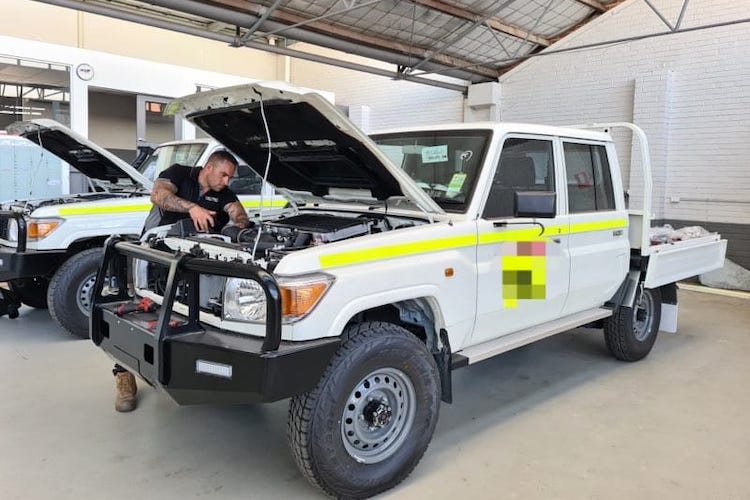Operating in the mining sector requires adherence to stringent safety standards, particularly when it comes to the specification and modification of site vehicles.
At Voltaic, our mine spec vehicle fit out specialists have honed our expertise over 30 years of combined experience to meet the unique demands of various mining sites across Australia.
From underground loaders to surface haul trucks, our team ensures every vehicle not only meets industry standards but exceeds them, enhancing both safety and functionality.
Leveraging our experience, we’ve broken down the general mine spec vehicle requirements, as well as the specific requirements of industry giants like BHP, Rio Tinto, and FMG, to help you maximise the safety and compliance of your vehicle.
General Mine Spec Vehicle Requirements
Mine spec vehicles are central to maintaining high safety standards on mining sites.
These vehicles are equipped with specific modifications to navigate the rugged terrain and challenging environments typical of mines.
Safety Enhancements
- Rollover Protection Structures (ROPS): Strengthen the vehicle’s frame to protect occupants in the event of a rollover.
- Seat Belts and Safety Harnesses: Critical for keeping passengers secure, regardless of the terrain.
- Fire Extinguishers and First Aid Kits: Readily available in case of emergencies.
Visibility and Communication
- Flashing Beacons and High-Visibility Flags: Ensure vehicles are visible in low light and dusty conditions.
- UHF Two-Way Radios: Facilitate reliable communication over long distances, crucial in expansive mine sites where signals are weak.
Operational Safety Features
- ABS Brakes: Help maintain control by preventing wheel lock during sudden stops.
- Battery Isolators: Critical in managing electrical hazards, ensuring the vehicle can be electrically deactivated, preventing accidental startups or fires.
- Heavy-Duty Tyres and Spill Kits: Tyres suited for rough terrain and spill kits for immediate response to fluid leaks or spills.
Mine Spec Vehicle Requirements in WA
The general mine spec vehicle requirements in WA are outlined comprehensively in the Mines Safety and Inspection Regulations 1995, available here.
These regulations mandate several critical safety features such as braking systems, roll over protection, fire suppression systems, and effective lighting and signalling on vehicles to promote a safe mining environment.
Braking Systems
- Vehicles must have service, emergency, and parking brakes.
- Brakes must be tested and maintained in accordance with manufacturer specifications.
Roll Over Protection
- Earth moving machinery must have roll over protective structures conforming to AS 2294.
Seat Belts
- Vehicles must be fitted with seat belts conforming to AS 2664 or Australian Design Rules.
Fire Suppression
- Diesel units rated at 125 kW or more must have an AFFF or FFFP fire suppression system.
- Remote-controlled units must have an automatic fire suppression system that can be activated remotely.
Lighting and Signals
- Vehicles must be equipped with effective headlights, tail lights, turn indicators, and audible warning signals.
- Light service vehicles and personnel transport vehicles must have a flashing light on the cab.
Emergency Stop Devices
- Vehicles must have emergency stop devices that are prominent, clearly marked, and immediately accessible to the operator.
Exhaust and Emissions
Exhaust Treatment
- Diesel units rated at 125 kW or more, or turbocharged, must have exhaust treatment devices.
- Exhaust treatment devices must be maintained and replaced if defective.
Gas Sampling and Emissions
- Undiluted exhaust gas from diesel units must be sampled and analysed regularly.
- Emissions must not exceed specified levels of carbon monoxide and nitrogen oxides.
- Opacity measurements of emissions must be within acceptable limits.
Ventilation
- Minimum ventilation volume rates must be maintained based on engine output.
- Combined ventilation requirements apply when multiple diesel units operate in the same ventilation circuit.
Mine Spec Vehicle Requirements in Queensland
The mine spec vehicle requirements in Queensland are outlined comprehensively in the Mining and Quarrying Safety and Health Regulation 2017, which can be reviewed here.
This regulation covers a range of safety features including brakes, roll over protection, fire suppression, and lighting and signals, to ensure vehicles are suitably equipped for mine operations.
Braking Systems
- Vehicles must have service, emergency, and parking brakes.
- Brakes must be tested and maintained in accordance with manufacturer specifications.
Roll Over Protection
- Earth moving machinery must have roll over protective structures conforming to AS 2294.
Seat Belts
- Vehicles must be fitted with seat belts conforming to AS 2664 or Australian Design Rules.
Fire Suppression
- Diesel units rated at 125 kW or more must have an AFFF or FFFP fire suppression system.
- Remote-controlled units must have an automatic fire suppression system that can be activated remotely.
Lighting and Signals
- Vehicles must be equipped with effective headlights, tail lights, turn indicators, and audible warning signals.
- Light service vehicles and personnel transport vehicles must have a flashing light on the cab.
Exhaust and Emissions
Exhaust Treatment
- Diesel units rated at 125 kW or more, or turbocharged, must have exhaust treatment devices.
- Exhaust treatment devices must be maintained and replaced if defective.
Gas Sampling and Emissions
- Undiluted exhaust gas from diesel units must be sampled and analysed regularly.
- Emissions must not exceed specified levels of carbon monoxide and nitrogen oxides.
- Opacity measurements of emissions must be within acceptable limits.
Ventilation
- Minimum ventilation volume rates must be maintained based on engine output.
- Combined ventilation requirements apply when multiple diesel units operate in the same ventilation circuit.
BHP Mine Spec Vehicle Requirements
The BHP mine spec vehicle requirements include safety rating requirements, modification prohibitions, HOV-specific controls, and compliance and risk management requirements.
These are meticulously detailed in their Safety Requirements document, particularly in Appendix 1, which all BHP and contractor light vehicles must adhere to.
Safety Ratings
- Vehicles must achieve a 5-star safety rating from recognised vehicle assessment programs including ANCAP, Euro NCAP, Latin NCAP, ASEAN NCAP, or NHTSA.
- Additionally, vehicles need a “Good” rating in both frontal and side crash tests from IIHS to ensure maximum occupant protection.
Prohibited Modifications
- Any aftermarket modifications that could negatively impact the vehicle’s safety features are strictly forbidden.
- This ensures that all vehicles maintain their integrity in terms of manufacturer safety standards.
High Occupancy Vehicles (HOVs)
For vehicles carrying nine or more people, the following safety controls must be in place:
- Fire extinguishers or fire suppression systems.
- Systems for monitoring driver behaviour, including speed.
- 3-point seat belts for all occupants.
- Anti-lock Braking System (ABS), Electronic Stability Control (ESC), and proper tyre selection and maintenance.
- A journey risk assessment and management plan must be implemented for all HOV journeys, and drivers must hold relevant local licenses and be verified as competent for the operating conditions.
Compliance and Risk Management
- If a vehicle does not meet Appendix 1 requirements, or if modifications are necessary, a detailed risk assessment must be conducted.
- Approval must be obtained, and appropriate controls must be implemented to manage and mitigate any potential risks.
For more information, you can review BHP’s safety requirements here.
Rio Tinto Mine Spec Vehicle Requirements
The Rio Tinto mine spec vehicle requirements focus on safety features, seat belts and fixed seats, speedometers and warning devices, brake systems, and towing restrictions.
Safety Features
- Electronic Stability Control (ESC)
- Anti-lock Braking System (ABS)
- Three-point seat belts with pretensioners
- Side, curtain, and front airbags
Fixed Seats and Safety Belts
- All vehicles must have fixed seats and safety belts for the driver and all passengers unless a risk assessment, approved by the area manager, specifies otherwise.
Speedometers and Warning Devices
- Vehicles must be equipped with a speedometer and warning devices to prevent inadvertent interaction with pedestrians and objects.
Braking Systems
- A risk-based process must be in place for periodically testing the effectiveness of braking systems.
Towing Restrictions
- No vehicle is permitted to tow equipment unless it is specifically engineered to do so.
For more information, you can review Rio Tinto’s Group Standard C3 for Vehicles and Driving here.
BMA Mine Spec Vehicle Requirements
The BMA mine spec vehicle requirements adhere to the overarching BHP vehicle safety standards listed in the BHP section, but are tailored to fit the specific needs of their operations.
Safety Ratings
- Vehicles must achieve a 5-star safety rating from recognised vehicle assessment programs including ANCAP, Euro NCAP, Latin NCAP, ASEAN NCAP, or NHTSA.
- Additionally, vehicles need a “Good” rating in both frontal and side crash tests from IIHS to ensure maximum occupant protection.
Prohibited Modifications
- Any aftermarket modifications that could negatively impact the vehicle’s safety features are strictly forbidden.
- This ensures that all vehicles maintain their integrity in terms of manufacturer safety standards.
High Occupancy Vehicles (HOVs)
For vehicles carrying nine or more people, the following safety controls must be in place:
- Fire extinguishers or fire suppression systems.
- Systems for monitoring driver behaviour, including speed.
- 3-point seat belts for all occupants.
- Anti-lock Braking System (ABS), Electronic Stability Control (ESC), and proper tyre selection and maintenance.
- A journey risk assessment and management plan must be implemented for all HOV journeys, and drivers must hold relevant local licenses and be verified as competent for the operating conditions.
Compliance and Risk Management
- If a vehicle does not meet Appendix 1 requirements, or if modifications are necessary, a detailed risk assessment must be conducted.
- Approval must be obtained, and appropriate controls must be implemented to manage and mitigate any potential risks.
Custom Safety Features
- Given the varied terrain and operational requirements at BMA sites, vehicles may be fitted with additional safety features such as enhanced suspension systems for rough terrain and extra dust protection measures.
For more information, you can review BHP’s safety requirements here.
FMG Mine Spec Vehicle Requirements
The FMG mine spec vehicle requirements place a strong emphasis on safety features, fixed seats and safety belts, speedometers and warning devices, brake systems, towing systems, and pre-operational safety checks.
Safety Features for Light Vehicles
- Electronic Stability Control (ESC)
- Anti-lock Braking System (ABS)
- Three-point seat belts with pretensioners
- Side, curtain, and front airbags
Fixed Seats and Safety Belts
- All vehicles must have fixed seats and safety belts for the driver and all passengers unless a risk assessment, approved by the area manager, specifies otherwise.
Speedometers and Warning Devices
- Vehicles must be equipped with a speedometer and warning devices to prevent inadvertent interaction with pedestrians and objects.
Braking Systems
- A risk-based process must be in place for periodically testing the effectiveness of braking systems.
Towing Restrictions
- No vehicle is permitted to tow equipment unless it is specifically engineered to do so.
Pre-operational Safety Checks
- All vehicles must undergo a pre-operational safety check, the frequency and content of which are determined by a risk assessment.
For more information, review Appendix 1 of FMG’s safety requirements document here.
Conclusion
In this blog, we’ve examined the detailed mine spec vehicle requirements laid out by prominent mining corporations such as BHP, Rio Tinto, BMA, and FMG.
Each of these industry leaders mandates strict safety standards to mitigate risks associated with the rugged and demanding environments of mining sites.
At Voltaic, we are dedicated to providing vehicle fit-outs that ensure maximum safety, compliance, and reliability.
We understand the critical importance of each component in a mine spec vehicle, from the roll cages designed to protect occupants in a rollover, to the advanced braking systems that prevent accidents on slippery or uneven terrain.
If you need expert advice on customising your vehicles to comply with specific mine site requirements or would like a free quote for your customised fit out, visit our mine spec vehicle fit out page today!

